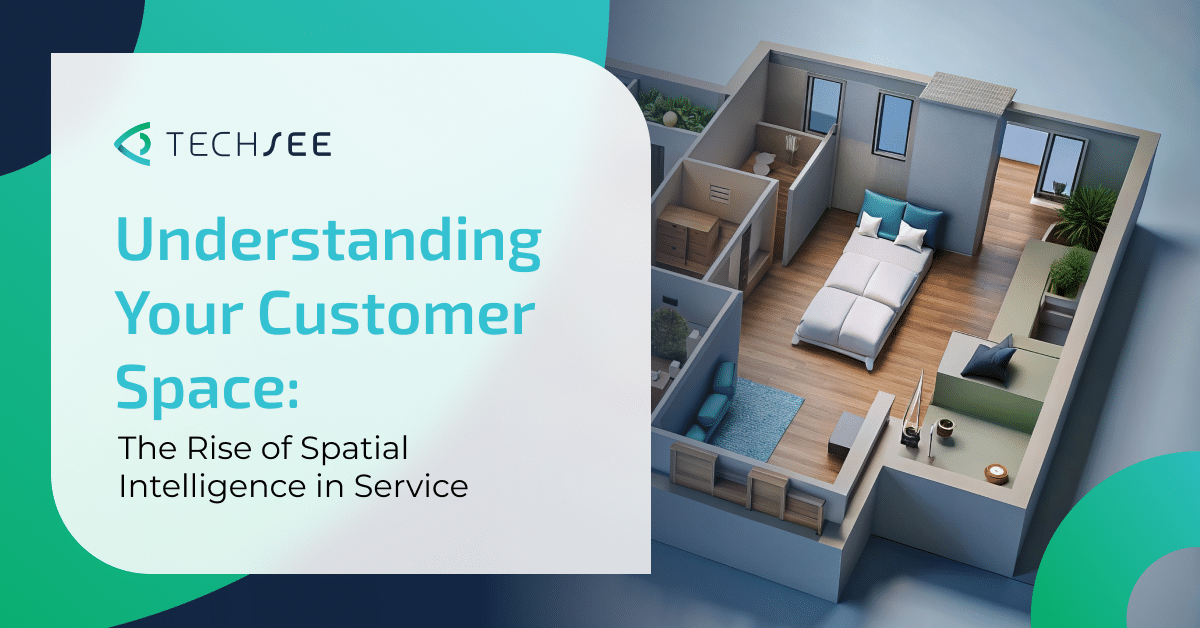Contents
- Understanding Your Customer Space: The Rise of Spatial Intelligence in Service
- What Is Spatial Intelligence in AI?
- From Visual Recognition to Spatial Understanding
- Spatial Intelligence in Action: Turning Service Environments into Digital Twins
- Why Spatial Intelligence Is a Greenfield for AI Innovation
- The Business Value of Spatial Understanding
- From 2D AI to 3D Intelligence: What Comes Next
- Conclusion
- FAQ: Spatial Analysis in Customer Service
- 1. What is spatial intelligence in AI?
- 2. How does spatial intelligence differ from visual AI?
- 3. What is AI spatial analysis used for?
- 4. How do digital twins relate to spatial intelligence?
- 5. Why is spatial intelligence important for customer service?
- 6. What is the difference between spatial intelligence and location intelligence?
Understanding Your Customer Space: The Rise of Spatial Intelligence in Service
Artificial intelligence has learned to process language and interpret visuals. Language models taught AI to read and write; visual models taught it to see. Yet both share the same limitation: they interpret information in isolation. They can identify a router or a light switch, but not that the router is hidden behind a metal cabinet or the camera is facing direct sunlight.
The next frontier in AI is spatial intelligence, which is teaching systems to understand the physical world they operate in. This evolution gives AI a sense of place, enabling it to connect vision, depth, and environment into a single understanding of how objects relate, interact, and influence one another.
What Is Spatial Intelligence in AI?
Spatial intelligence in AI refers to a system’s ability to perceive, model, and reason about space beyond objects or patterns. It uses computer vision, 3D modeling, and context to see how things relate and work together. In practical terms, AI spatial analysis helps machines answer where and why, not just what.
- Where is the object located?
- How does its position, orientation, or environment affect performance?
- Why might a certain outcome occur in that configuration?
This is the same leap humans make instinctively. We don’t just recognize a coffee mug; we know it’s on the edge of a table, half full, and close to being spilled. AI spatial intelligence brings that same environmental awareness to machines.
From Visual Recognition to Spatial Understanding
Visual AI transformed industries by allowing machines to identify and classify objects in images. Spatial intelligence goes further by interpreting relationships between objects, people, and their surroundings.
In customer service, this distinction matters. Traditional visual models can recognize a device. Spatially intelligent systems understand how that device fits into its environment. For example, a cognitive agent assist tool might identify a Wi-Fi router.
A spatially aware AI can see that it’s placed too close to a thick wall or metal shelf. This data can explain why the signal keeps dropping. This shift transforms troubleshooting from symptom management to environmental understanding, from recognizing the issue to understanding its context.
Spatial Intelligence in Action: Turning Service Environments into Digital Twins
Spatial analysis enables the creation of digital twins, virtual representations of real-world customer environments that update dynamically as AI systems observe them. Each interaction becomes an opportunity to capture what’s broken and how the surrounding space contributes to it.
Across industries, this capability is redefining efficiency and insight:
- Telecom and Smart Home:
Spatial intelligence gives providers a real view into how connectivity behaves inside a home, not just what the modem reports. AI can map Wi-Fi coverage, signal attenuation, and device placement across rooms. It can identify weak spots caused by walls, furniture, or interference. Instead of guessing why performance drops, service teams can pinpoint the cause in seconds and offer placement recommendations that actually work.
- Insurance:
Insurers can use customer-captured spatial scans to build a clear picture of home layouts, structural challenges, or potential hazards before a claim is filed. This enables more accurate underwriting decisions and reduces the risk of surprises during post-claim inspections. Spatial analysis also helps detect coverage gaps, verify environmental conditions, and document property state with higher confidence.
- Utilities and Energy:
Spatial models of HVAC units, electrical panels, or solar installations allow utilities to perform remote inspections with the same clarity previously possible only on-site. AI can flag improper placement, airflow obstructions, or shading patterns that affect system performance. By understanding how equipment interacts with its physical environment, providers can shift from reactive maintenance to proactive planning.
- Manufacturing and Retail:
3D spatial mapping supports assembly-line accuracy by verifying that components, machines, and workspaces are positioned correctly. In retail environments, spatial intelligence can monitor shelf layouts, planograms, and foot-traffic flow to identify inefficiencies or compliance gaps. This creates a reliable, real-world view that helps teams optimize operations and reduce human error at scale.
Spatial intelligence bridges what AI sees with how it interprets space, producing contextual, measurable understanding that supports informed decisions and smarter automation.
Why Spatial Intelligence Is a Greenfield for AI Innovation
While AI language and vision models are now mature, spatial reasoning remains largely untapped. The technology foundation already exists; modern smartphones and cameras can capture 3D depth and spatial geometry, but few organizations are yet integrating this data into service workflows.
For customer service, this represents a new frontier. Imagine AI-guided agents that not only understand a product but also the environment it operates in, seeing how placement, distance, or lighting affect performance. This enhances troubleshooting and it reshapes how support, maintenance, and product design are connected.
The long-term impact is profound. Spatial AI creates a shared understanding between the customer, the agent, and the system. Every visual interaction becomes a data point in a real-time spatial model, a continuously learning digital twin that captures the problem and its physical context.
The Business Value of Spatial Understanding
The ROI of spatial intelligence comes from its ability to convert environmental context into operational value.
- Efficiency: Problems that once required site visits can now be diagnosed remotely with 3D insight.
- Customer Experience: Agents deliver faster, more confident resolutions by seeing and explaining exactly what’s happening.
- Revenue Growth: With spatial data, organizations can offer personalized recommendations from optimized device placement to tailored product add-ons.
- Risk Reduction: Insurers, field service providers, and manufacturers gain better visibility into environmental risks before they become claims.
From 2D AI to 3D Intelligence: What Comes Next
Spatial intelligence represents the next stage in the AI maturity curve. Language models taught AI to communicate; vision models taught it to perceive; spatial intelligence will teach it to comprehend.
The next generation of multimodal AI agents won’t just read, listen, and see. But they’ll also navigate, measure, and reason about the world around them. For customer service, that means moving from reactive problem-solving to proactive foresight, understanding the issue and the conditions that create it.
Conclusion
Spatial intelligence is redefining what it means for AI to “understand.” By combining vision, depth, and environmental context, it transforms service from observation to comprehension. This is the greenfield of AI, where digital twins merge with cognitive reasoning.
Every customer interaction helps build a smarter understanding of the real world. The leap ahead won’t come from teaching AI to talk better. It will come from teaching it to understand space because when AI can see and reason in 3D, it can solve problems and even understand them.
FAQ: Spatial Analysis in Customer Service
1. What is spatial intelligence in AI?
Spatial intelligence in AI is the ability to understand spatial relationships between objects, environments, and context. It enables systems to reason about space, depth, and placement, connecting vision with real-world understanding.
2. How does spatial intelligence differ from visual AI?
Visual AI recognizes and classifies objects. Spatial intelligence interprets how those objects relate to one another and to their environment, adding context to perception.
3. What is AI spatial analysis used for?
AI spatial analysis helps industries model environments, optimize layouts, detect risks, and perform context-aware automation. In customer service, it supports faster diagnosis and proactive resolution.
4. How do digital twins relate to spatial intelligence?
Digital twins are 3D, data-rich replicas of physical environments. Spatial intelligence enables AI to generate and update these models automatically using visual and sensor data.
5. Why is spatial intelligence important for customer service?
Since most service issues happen in context, spatial awareness helps AI understand why something went wrong, not just what went wrong. Thus, it reduces escalations and builds customer trust.
6. What is the difference between spatial intelligence and location intelligence?
Location intelligence shows where things are using maps, coordinates, and geospatial data. Spatial intelligence goes further by interpreting how objects exist, move, and interact in space. The spatial intelligence AI definition highlights how AI understands 3D environments, relationships, and context. Hence, it is broader and more dynamic than location intelligence.






